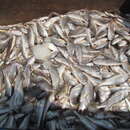Diagnostic Description
provided by FAO species catalogs
Body elongated and compressed. Scales on body mostly ctenoid (comb-like); scales on breast and head smaller and cycloid. Lateral line extending to tip of caudal fin. Head short; eye rather large, its diameter contained 3.6 to 4.6 times in head length; mouth large, strongly oblique, either terminal or lower jaw slightly projecting; maxilla extending beyond hind margin of eye; teeth small, set in narrow bands in jaws; outer row in upper jaw, and inner row in lower jaw slightly enlarged ; chin without barbel but with 6 pores, the medial pair located at tip of lower jaw; snout with 5 marginal pores only. Gillrakers long and slender, longer than gill filaments at angle of arch, 19 to 22 on first gill arch. Preopercular margin serrated, with a few strong spines at angle. Dorsal fin with 10 spines and I + 29 to 34 (usually 31 or 32). Anal fin with 2 spines and 6 soft rays, the second spine very strong, about equal in length to first soft ray. Caudal fin pointed (juveniles) to rhomboidal (adults). Anterior end of swimbladder with one pair of appendages dividing into a group of short anterior branches and a series of 5 or 6 long tubes running backward for about half the length of bladder. Sagitta (earstone) ovoid, thick, twisted around longitudinal axis, its outer surface covered with large granules. Colour silvery grey with a reddish tint often witch oblique lines and scattered dark spots on back; belly yellowish during breeding season; fins greyish; dark spots on soft part of dorsal fin forming 2 or 3 longitudinal rows; tip of first dorsal fin dusky, pelvic and anal fins yellowish.
- Bauchot, M-L. - 1966Poissons marins de l'Est Atlantique Tropical. Téléostéens Perciformes. II. Percoidei (3ème partie). III. Acanthuroidei. IV. Balistoidei. Atlantide Report (9): 7-43.
- Chao, L. N & E. Trewavas. - 1990 Carangidae. In: J.C. Quero et al., (eds.) Check-list of the fishes of the eastern tropical Atlantic (CLOFETA). Unesco, Portugal, vol. II: 813-826.
Distribution
provided by FAO species catalogs
Only along the West African coast, from Senegal to Angola (possibly extending further north).
Size
provided by FAO species catalogs
Maximum 45 cm; common to 30 cm.
Brief Summary
provided by FAO species catalogs
Coastal waters over mud bottomfrom shoreline to about 50 m depth;also enters estuaries and coastal lagoons;moves farther offshore (to about 100 m) for spawning during rainy season (December to February).
Benefits
provided by FAO species catalogs
An important foodfish. Caught with bottom trawls, set nets, beach seines and on line gear. The total catch reported for this species to FAO for 1999 was 6 679 t. The countries with the largest catches were Guinea (2142 t) and Cameroon (1 900 t). Marketed fresh, dried salted and smoked.
Diagnostic Description
provided by Fishbase
Diagnosis: medium-sized fish, fusiform/elongate and laterally compressed (Ref. 57396, 81656). Head and snout short (Ref. 57396). Eyes rather large (Ref. 57396, 81656), 3.6-4.6 times in HL, but this character is difficult to use for identification because of allometry (Ref. 81656). Mouth large and oblique (Ref. 57396, 81656), subterminal (Ref. 57396). Maxilla extending beyond posterior eye border (Ref. 81656). Teeth villiform, set in narrow bands in both jaws; 5 marginal pores on snout and 6 mental pores (Ref. 57396). Gill rakers long (Ref. 57396, 81656) and slender (Ref. 57396), longer than gill filaments at angle of first gill arch (Ref. 57396, 81656), 11-16/1/5-8 (total 19-25) on 1st gill arch (Ref. 81656). Lower part of 1st gill arch with 0-5 reduced additional gill rakers, upper part with 0-3 reduced additional ones; preopercular edge denticulate, with a few strong spines in the corner (Ref. 81656). Dorsal fin long, deeply notched (Ref. 57396), with 10 spines in 1st part and 1 spine and 29-35 soft rays in 2nd part (Ref. 81656). 2nd anal fin spine very strong, about as long as 1st soft ray (Ref. 57396, 81656) and comprised less than twice in head length (Ref. 57396). Pectoral fins long, 23.6-29.6% SL (Ref. 81656). Caudal fin more or less pointed (Ref. 57396, 81656) or rhomboidal (Ref. 81656). Scales ctenoid on body, cycloid on breast and head; lateral line extending to hind margin of caudal fin; swim bladder carrot-shaped, its front end with a pair of appendages subdividing into a group of short anterior branches and a bundle of 5-6 slender tubes extending backwards over half the length of swim bladder (Ref. 57396).Coloration: general colour silver-grey witha reddish sheen (Ref. 81656), back olivaceous brown (Ref. 57396) with series of dark dots, belly light, yellowish during reproduction period (Ref. 57396, 81656). Dorsal and caudal fins greyish (Ref. 81656). Spinous part of dorsal fin dark, soft part lighter, with 2-3 longitudinal series of dark dots; pelvics and anal fin yellowish (Ref. 57396, 81656).
Morphology
provided by Fishbase
Dorsal spines (total): 11; Dorsal soft rays (total): 29 - 35; Anal spines: 2; Analsoft rays: 6 - 7
Trophic Strategy
provided by Fishbase
Feeds on fish and shrimps (Ref. 28587).
Biology
provided by Fishbase
Found in coastal waters over mud bottom (Ref. 3593, 57396, 81656), very close to the shore (Ref. 57396). Also enters estuaries and coastal lagoons (Ref. 3593, 81656), where reproduction takes place (Ref. 57396). Moves farther offshore to about 100 m for spawning during rainy season from December to February; feeds on (juvenile) fish, shrimps (Ref. 28587, 81656) and other crustaceans (Ref. 81656).
Importance
provided by Fishbase
fisheries: commercial; gamefish: yes

